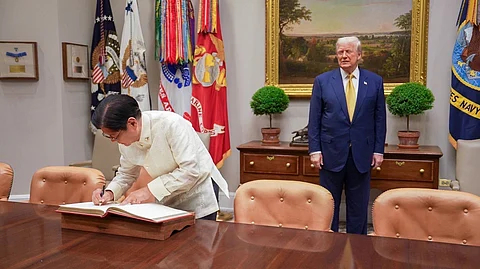
- NEWS
- the EDIT
- COMMENTARY
- BUSINESS
- LIFE
- SHOW
- ACTION
- GLOBAL GOALS
- SNAPS
- DYARYO TIRADA
- MORE

As United States President Donald Trump provided a little leeway on tariff rates — cutting the rate to 19 percent on all US-bound Philippine products — various business groups have hesitated to weigh in on whether they welcome the move.
“We are still studying and discussing this issue. Please give us a little time,” said Philippine Chamber of Commerce and Industry president Enunina Mangio when asked for comment on Wednesday.
The PCCI earlier expressed concerns over the US decision to impose a 20 percent tariff on Philippine exports, warning that the additional duties could hurt the country's competitiveness in the global market.
The Makati Business Club also requested ample time to react, as they are still waiting for important details from the negotiations between Trump and President Ferdinand Marcos Jr. on Tuesday.
“Specifically, we need to know if electronics are exempt, since that is our principal export to the US,” said Apa Ongpin, executive director of the MBC.
For Sergio Ortiz-Luis Jr., president of the Philippine Exporters Confederation, Inc., he declined to comment, saying he has “no good words” for the newly imposed export tax rates.
Meanwhile, Rizal Commercial Banking Corporation Chief Economist Michael Ricafort said the reduced 19 percent tariff rate from the previous 20 percent was “not a complete surprise.”
“The latest 19 percent U.S. import tariffs on Philippine goods/exports to the US is slightly higher than the 17 percent previous reciprocal tariffs on 2 April but similar nevertheless,” Ricafort said in a Viber message.
He added, “These tariffs are still subject to negotiations with the US if these rates would be lowered by the 1 August extended deadline, as Trump has signaled no further extension after that.”
According to the Philippine Statistics Authority, the US was the Philippines’ top export destination in May 2025, contributing $1.115 billion or 15.3 percent of total export value.
Ricafort said that aside from electronics, all Philippine exports to the US will be subject to a 19 percent tax, increasing prices for consumers or exporters depending on market agreements.
Asked for an estimate of the added export costs, Ricafort said it was difficult to quantify but warned of reduced demand, lower earnings, job losses, and weaker business performance across supply chains.
He emphasized that the new tariffs could hinder global trade, investment, employment, and GDP growth, which could indirectly dampen the Philippines’ own economic growth.
So far, US tariffs on Philippine goods are among the lowest announced by Trump — likely in exchange for the country’s offer of zero tariffs on American vehicle imports.
In comparison, Japan received a 15 percent tariff (down from 25 percent) after agreeing to open its market to US cars, trucks, and agricultural products. Indonesia also got 19 percent (from 32 percent), while Vietnam was levied 20 percent, but suspected transshipments from China through Vietnam would be taxed at 40 percent.
South Korea and Malaysia received 25 percent; China, 30 percent; Thailand and Cambodia, 36 percent; and Laos and Myanmar, 40 percent.
The ASEAN+3 Macroeconomic Research Office (AMRO) also slashed its growth outlook for the region, citing trade uncertainties from the new US tariffs.
AMRO lowered its 2025 GDP forecast to 3.8 percent and its 2026 projection to 3.6 percent — down from the earlier 4.2 percent forecast.
“Reflecting heightened global uncertainties, particularly the evolving US tariff measures, the growth forecasts represent a downward revision,” AMRO said in a statement.
Despite this, AMRO Chief Economist Dr. Dong He said the ASEAN+3 region remains resilient. “Most regional policymakers have acted early to cushion the impact of the trade shock, and policy space remains available for further support if needed.”
He warned that escalating US tariffs and uneven negotiations could further disrupt trade and dampen growth.
“In a world increasingly reshaped by fragmentation, deeper regional integration is both urgent and necessary,” He said. “By strengthening regional cooperation... ASEAN+3 can build resilience against external shocks and create new growth opportunities.”
